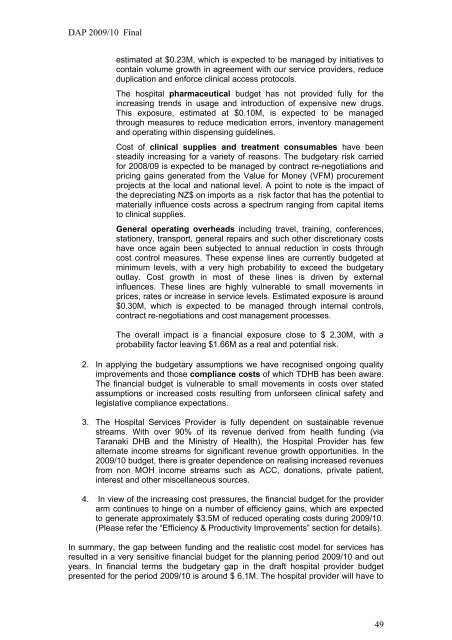DAP 2009/10 Final 1 - Taranaki District Health Board
DAP 2009/10 Final 1 - Taranaki District Health Board
DAP 2009/10 Final 1 - Taranaki District Health Board
You also want an ePaper? Increase the reach of your titles
YUMPU automatically turns print PDFs into web optimized ePapers that Google loves.
<strong>DAP</strong> <strong>2009</strong>/<strong>10</strong> <strong>Final</strong>estimated at $0.23M, which is expected to be managed by initiatives tocontain volume growth in agreement with our service providers, reduceduplication and enforce clinical access protocols.The hospital pharmaceutical budget has not provided fully for theincreasing trends in usage and introduction of expensive new drugs.This exposure, estimated at $0.<strong>10</strong>M, is expected to be managedthrough measures to reduce medication errors, inventory managementand operating within dispensing guidelines.Cost of clinical supplies and treatment consumables have beensteadily increasing for a variety of reasons. The budgetary risk carriedfor 2008/09 is expected to be managed by contract re-negotiations andpricing gains generated from the Value for Money (VFM) procurementprojects at the local and national level. A point to note is the impact ofthe depreciating NZ$ on imports as a risk factor that has the potential tomaterially influence costs across a spectrum ranging from capital itemsto clinical supplies.General operating overheads including travel, training, conferences,stationery, transport, general repairs and such other discretionary costshave once again been subjected to annual reduction in costs throughcost control measures. These expense lines are currently budgeted atminimum levels, with a very high probability to exceed the budgetaryoutlay. Cost growth in most of these lines is driven by externalinfluences. These lines are highly vulnerable to small movements inprices, rates or increase in service levels. Estimated exposure is around$0.30M, which is expected to be managed through internal controls,contract re-negotiations and cost management processes.The overall impact is a financial exposure close to $ 2.30M, with aprobability factor leaving $1.66M as a real and potential risk.2. In applying the budgetary assumptions we have recognised ongoing qualityimprovements and those compliance costs of which TDHB has been aware.The financial budget is vulnerable to small movements in costs over statedassumptions or increased costs resulting from unforseen clinical safety andlegislative compliance expectations.3. The Hospital Services Provider is fully dependent on sustainable revenuestreams. With over 90% of its revenue derived from health funding (via<strong>Taranaki</strong> DHB and the Ministry of <strong>Health</strong>), the Hospital Provider has fewalternate income streams for significant revenue growth opportunities. In the<strong>2009</strong>/<strong>10</strong> budget, there is greater dependence on realising increased revenuesfrom non MOH income streams such as ACC, donations, private patient,interest and other miscellaneous sources.4. In view of the increasing cost pressures, the financial budget for the providerarm continues to hinge on a number of efficiency gains, which are expectedto generate approximately $3.5M of reduced operating costs during <strong>2009</strong>/<strong>10</strong>.(Please refer the “Efficiency & Productivity Improvements” section for details).In summary, the gap between funding and the realistic cost model for services hasresulted in a very sensitive financial budget for the planning period <strong>2009</strong>/<strong>10</strong> and outyears. In financial terms the budgetary gap in the draft hospital provider budgetpresented for the period <strong>2009</strong>/<strong>10</strong> is around $ 6.1M. The hospital provider will have to49
















